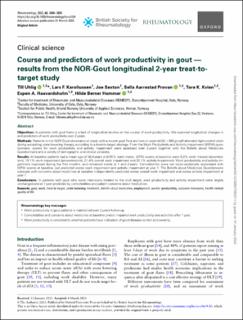| dc.contributor.author | Uhlig, Till | |
| dc.contributor.author | Karoliussen, Lars Fridtjof | |
| dc.contributor.author | Sexton, Joseph | |
| dc.contributor.author | Provan, Sella Aarrestad | |
| dc.contributor.author | Kvien, Tore Kristian Aaserud | |
| dc.contributor.author | Haavardsholm, Espen A. | |
| dc.contributor.author | Hammer, Hilde Berner | |
| dc.date.accessioned | 2024-02-09T09:37:31Z | |
| dc.date.available | 2024-02-09T09:37:31Z | |
| dc.date.created | 2023-11-28T11:49:48Z | |
| dc.date.issued | 2023 | |
| dc.identifier.citation | Rheumatology. 2023, 62 (12), 3886-3892. | en_US |
| dc.identifier.issn | 1462-0324 | |
| dc.identifier.uri | https://hdl.handle.net/11250/3116549 | |
| dc.description.abstract | Objectives In patients with gout there is a lack of longitudinal studies on the course of work productivity. We explored longitudinal changes in and predictors of work productivity over 2 years. Methods Patients in the NOR-Gout observational study with a recent gout flare and serum urate (sUA) >360 µmol/l attended tight-control visits during escalating urate lowering therapy according to a treat-to-target strategy. From the Work Productivity and Activity Impairment (WPAI) questionnaire, scores for work productivity and activity impairment were assessed over 2 years together with the Beliefs about Medicines Questionnaire and a variety of demographic and clinical variables. Results At baseline patients had a mean age of 56.4 years and 95% were males. WPAI scores at baseline were 5.0% work missed (absenteeism), 19.1% work impairment (presenteeism), 21.4% overall work impairment and 32.1% activity impairment. Work productivity and activity impairment improved during the first months, and remained stable at 1 and 2 years. Comorbidities were not cross-sectionally associated with WPAI scores at baseline, but predicted worse work impairment and activity impairment at year 1. The Beliefs about Medicines Questionnaire subscale with concerns about medicines at baseline independently predicted worse overall work impairment and worse activity impairment at year 1. Conclusions In patients with gout who were intensively treated to the sUA target, work productivity and activity impairment were largely unchanged and at 1 year predicted by comorbidities and patient concerns about medication. | |
| dc.language.iso | eng | en_US |
| dc.rights | Navngivelse 4.0 Internasjonal | * |
| dc.rights.uri | http://creativecommons.org/licenses/by/4.0/deed.no | * |
| dc.title | Course and predictors of work productivity in gout - results from the NOR-Gout longitudinal 2-year treat-to-target study | en_US |
| dc.title.alternative | Course and predictors of work productivity in gout - results from the NOR-Gout longitudinal 2-year treat-to-target study | en_US |
| dc.type | Peer reviewed | en_US |
| dc.type | Journal article | en_US |
| dc.description.version | publishedVersion | |
| dc.source.pagenumber | 3886-3892 | en_US |
| dc.source.volume | 62 | en_US |
| dc.source.journal | Rheumatology | en_US |
| dc.source.issue | 12 | en_US |
| dc.identifier.doi | 10.1093/rheumatology/kead124 | |
| dc.identifier.cristin | 2203666 | |
| dc.relation.project | Norges forskningsråd: 328657 | |
| cristin.ispublished | true | |
| cristin.fulltext | original | |
| cristin.qualitycode | 2 | |

